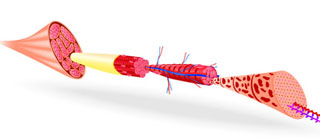2 Types of Muscle Injuries That Cause Lower Back Pain
By Sherwin Nicholson | SN Health Resources | Updated May 7, 2020

The 2 common injuries are strains and contusions
Strains
Strains occur when a muscle is pulled or extended beyond its tensile limits. This happens from overstretching. Strain also occurs by forcing the tissue to contract or remain contracted beyond it limits until failure.
Anytime you feel as though you just pulled a muscle in your back, it is because of a strain.
Fibers begin to tear and hurt. The severity of the injury is due to the amount of excessive force placed.
It is common to have a strain from non contact sports or activities where you may be running, jumping or stretching. Some of these activities involve the very intense (eccentric) contractions that lead to a strain. Conversely, over stretching a muscle can create the same injury.
Examples of such strains can range from the following
- Overexertion during exercise or anything requiring brief very heavy lifting
- Pulling a muscle as a result of holding a heavy object for long periods of time
- Bending or twisting in an awkward angle
- Slipping or falling that causes a weaker muscle to become pulled
Contusions
Contusions occur when direct force is applied to the tissue. These are compression or crushing forces. This is also a soft-tissue injury. Contusions occur at or near the point of contact.
At the area of impact, there is local damage in which tissue is destroyed and local bleeding occurs. Contusions are visible by the appearance of a bruise at or near the site of contact.
Examples of contusions are from:
- Direct blows from sports or other physical activity
- Slips or falls where the body lands on the tissue
- Intense direct pressure from over manipulation or palpation
Muscle Strains are Graded from 1-3
In order to be properly diagnosed and treated, health care practitioners use a system which classifies an injury into 3 degrees or grades.
Grade 1 (Least Severe)
Grade 1 is the mildest form of strain. The fibers might or might not show signs of tearing when overstretched. There is usually a full recovery within a few days to a few weeks.
Some bruising may or may not be visible along with swelling. This grade is accompanied with some amount of discomfort.
Grade 2 (Moderately Severe)
Here, the overstretched tissue has signs of tearing with symptoms of both bruising and swelling. The intensity of pain is much higher. There is usually some amount of rupturing of the small blood vessels causing visible bruises.
Most people with this type of strain will find it difficult to move the joint associated with the strain. This grade usually requires 4-6 weeks for adequate recovery.
Grade 3 (Most Severe)
Grade 3 is the most intense and painful of the strains. Here, the fibers are overstretched to the point of serious and harmful tearing. Tears can range from a partial to complete tear and separation.
If you have ever had this kind of tear, you can recall the sickening moment of feeling and hearing a distinct, sudden, popping sound followed by intense pain and loss of movement.
The amount of damage you get from a tear is pretty significant often requiring 6-12 weeks of rest for partial tears. Surgery is usually recommended for full separations.
Did you know that a strained back can lead to muscle guarding?
It’s not a good sign when it does.
Strains can trigger spasms as one set of muscles try to restrict the movement of the body to protect the injured tissue. This type of protection is known as muscle guarding. For example, a strain can readily occur during simple movements.

A typical example, such as leaning sideways to reach something inside of your car.
A mild to moderate strain can occur during this movement. Small micro-tearing may occur causing severe discomfort and injury.
Other areas immediately tense up to restrict movement, effectively ‘locking’ you up.
Don’t strain over this….
One of the most likely causes of this injury is in a failure to reach for everyday objects in a safe manner. Poor posture when leaning, bending or twisting can easily trigger a strain and injury. Learning to use your spine safely while reaching is key to avoiding injury.
What are the 3 most common sources of lumbar pain?
- The effect of guarding
- The initially over-strained and torn muscles
- Possible lumbar disc and nerve injury.
This injury may require at least a few days to weeks to fully heal.
Although the tear will repair over time, other muscles which are guarding will cause very uncomfortable symptoms. Any possible lumbar disc or vertebrae injury may still be present.
It is important to find help for these issues as only treating the initial strain won’t help. The most vulnerable people to suffer from injury are those who are likely to be overactive (too much exertion) or under active (atrophy). Some symptoms of discomfort are likely present with poor sleep.
Are you suffering? It could be from a muscle injury. These injuries as described above are one of the most common causes. If you are looking for support for your discomfort, please read the following articles:
References:
The Facts – John Lee, Clare Daniel, Suzanne Brook. NY. Oxford University Press – 2009. 617.564Leewww.backcarecanada.cawww.spine-health.com/conditions/lb
www.back.com
www.mayoclinic.com
Sleep problems, exercise and obesity and risk of chronic musculoskeletal: the Norwegian HUNT study –http://www.ncbi.nlm.nih.gov/pubmed/24293504
